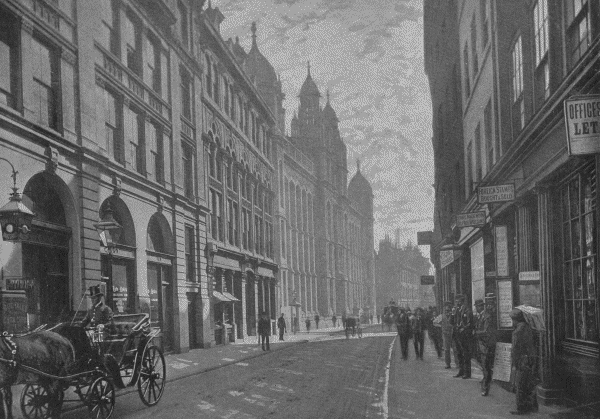Chancery Lane/Cursitor Street


These pictures (taken more than 120 years apart) both depict the same view from Chancery Lane, of Maughan Library and Old Public Records Office. The right picture was taken in 1896, only 44 years after the publication of Bleak House.

Chancery Lane was originally constructed by the Knights Templar as a way to connect their old and new headquarters, in the late 12th century. At the time, it was given the unique and very original name of New Street (read with heavy sarcasm). The Knights’ connection to the area is also the reason that Christopher Wren designed that “leaden-headed old obstruction, appropriate ornament for the threshold of a leaden-headed old corporation,” (Dickens 62) known as Temple Bar in 1670 (Ingham 62.3). New Street was later christened with its more modern name of Chancery Lane, after the area saw a large rise of Inns of Chancery/ Chancellery, places where students of law could apprentice. This change occurred in the early 13th century when, during his persecution and indoctrination of his Jewish subjects, Henry III closed all of the local law schools. Even today it is still considered the central hub of London’s legal affairs.
Cursitor is a small and clustered street that branches off Chancery Lane. It was named for the Cursitor’s Office/ Inn that is located at the intersection of Chancery Lane and Cursitor Street. The Inn was founded by the Lord Keeper of the Great Seal of England, Sir Nicholas Bacon. The Great Seal and its significance is mentioned early in Bleak House during scenes with the Old Woman and is given Biblical allusions (Dickens 88). The street is described in detail and further entwined with the Christain faith in Walter Thornbury’s 1878 Old and New London: Vol. 2 as a “corruption of chorister” because it was, “anciently all or the most part of the officers and ministers of Chancery, or Court of Conscience (for so the Chancery hath been called) were churchmen, divines, and canonists." The overlapping of Christianity with law and Chancery Lane through London’s history (with the Knights Templar, Henry III’s indoctrination of his Jewish people, and the reasons for its late 19th century moniker of “Court of Conscience”) supports Dickens’ Biblical metaphors and implications.
Sources:
Boorman, Francis. Wiley Online Library, John Wiley & Sons, Inc, 2015, onlinelibrary.wiley.com/cms/asset/007e5e8d-b5b9-4923-bd88-7cf36b6dc39f/hisr12122-fig-0001-m.jpg.
“Chancery Lane.” Hidden London, Word Press, 2020, hidden-london.com/gazetteer/chancery-lane/. Accessed 15 Oct. 2020.
Dickens, Charles, and Patricia Ingham. Bleak House. Broadview Editions, 2011.
Thornbury, Walter. "Holborn : To Chancery Lane." Old and New London: Volume 2. London: Cassell, Petter & Galpin, 1878. 526-542. British History Online. http://www.british-history.ac.uk/old-new-london/vol2/pp526-542. Accessed 15 Oct. 2020.
Unknown Photographer. “The New Public Record Office.” Victorian London, The Queen's London, 1896, https://www.victorianlondon.org/buildings/recordoffice.htm. Accessed 16 Oct. 2020.
Unknown Photographer. “28 CHANCERY LANE, WC2A.” Farebrother: Property In Focus. https://www.farebrother.com/properties/detail/203. Accessed 16 Oct. 2020.
Parent Map
Coordinates
Longitude: -0.112021400000
